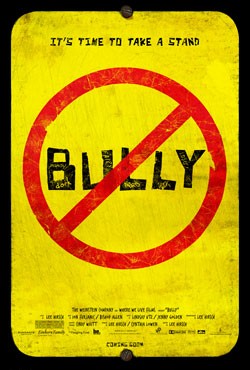
Opening to a cover of Wheatus’ Teenage Dirtbag by Scala and Kolacny Brothers (the Belgian girls choir who covered Radiohead’s Creep for The Social Network trailer), it took a second or two to adjust and realize this was not Bully, the 2001 made by director Larry Clark, but the documentary of the same name, formerly known as The Bully Project (though that sounds like some reality TV show).
This look at the effects of bullying comes from director Lee Hirsch, who presents the story of a handful of kids who suffered at the hands of classmates being cruel to them, amidst communities and school administrations unable and/or unwilling to step in. Since I’d like to end this review on a positive note, I’ll get my gripes out now.
Each of the featured kids come from towns no one would consider re-designating a “city”. I wouldn’t be surprised if the locals learned the definition of “diversity” via Ron Burgundy, i.e. as an old, old wooden ship that was used during the Civil War era. As we watch these kids suffer from not fitting in with the rest of the crowd, while there are certainly failings within the school system, the problems are more reflective of the community and their tolerance of anything different. It would have helped the overall case so much to see at least one kid living in a population big enough to have even a minor league baseball team stadium.
My other major concern is that like Waiting for Superman, the call to action is muted (though Bully is a far better film). What is it that people are supposed to do? Anyone living in an urban setting could shrug their shoulders and say, ‘Well I don’t live in podunksville so my child will likely never be singled out so distinctly’. And while the links to social media are present, it isn’t until near the very end of watching these children take inordinate amounts of crap from their peers and get little to no help from adults whose jobs it should be to protect them, that one father tells a group of teens that they should stand up for kids when they can’t stand up for themselves and make an effort to make anyone new or different feel welcome.
An additional minor complaint stems from one or two of the kids not getting enough development of their story. While I’m sure you could have made a full-length documentary using any one of them, if you’re going to cover multiple subjects, it would have been nice to have their coverage be a bit more balanced.
Aside from those factors, however, if you have kids/are planning to have kids/work with kids, this is a movie well worth watching. For those of us in big cities, bullies were fewer and farther between simply due to the scale of the landscape. Even if one found themselves the target of ridicule, there likely were others in similar situations who allowed for a sense of belonging that got you through. Let’s face it, nearly every child goes through a phase where the world is against them in some manner; whether it’s because they’re on the outskirts or too popular. Having the ability to blend into larger communities can lessen the abuse.
The kids featured in the documentary are all sweet kids, each with some attribute that engendered ridicule from their peers. Watching them be abused is hard to watch, as the normal instinct should be to want to step in. Making it worse is seeing their complaints fall upon deaf ears. One vice principal in particular may be one of the worst excuses for flesh I’ve seen on film in years; somehow able to work in the birth of her beautiful granddaughter to a discussion about a child being punched, stabbed with pencils, and having his head bashed into the seats on the school bus. Stay classy (and thank you for not being in San Diego). That they would act this way while BEING FILMED is even more astonishing.
It’s nice to see that the MPAA finally caved and allowed a PG-13 rating (I’ll leave out the hypocrisy of the MPAA right now). Aside from the difficulty in watching kids be cruel to one another and realizing their best option is often to move to a town more tolerant of diversity, the only material parents will find objectionable are a few snippets of bad language. Of course, when this language comes from the mouths of these children, the notion that we shouldn’t let our kids hear these words becomes rather moot. Sorry, parents. Your kids know these words. And they use these words. And a few nasty words shouldn’t be the reason you don’t watch this with your kids.
Since the active message of the film is not so overt, hopefully the ability to discuss the events on-screen with your kids either after they see it in a school setting or with you will open their eyes to the problems of bullying. Although the only examples in the film take place in red states where high school football is the hottest ticket in town, it doesn’t mean you’re safe in a big city. Kids are naturally cruel to one another as part of their maturation process, trying to fit in and hide any of their differences so as not to stick out and become the target of other kids. It’d be nice to live in a world where that doesn’t happen but don’t expect a radical change simply because one film points things out.
In reading some of the comments on the websites connected to the film, it’s evident that having this message presented can make a difference. And no matter if this uptick in common decency lasts only as long as the hoopla surrounding the project, each act of kindness generated is another act that may not have happened otherwise. So despite my misgivings about certain filmmaking aspects, Bully is an important film for you and your children to watch. Even if you don’t take away the motivation to help someone else out, simply being aware of the scope of the problem is beneficial so that instances formerly swept aside as “kids being kids” are treated with just that much more attention and thought.
GRADE: B+
Bully is rated PG-13 for some language.






